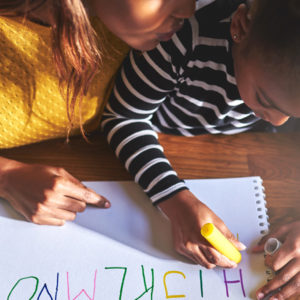It took TV chef Jamie Oliver till the age of 38 to discover a love of reading – but parents can help their dyslexic child learn to love reading at a much younger age.
Like many dyslexic readers, Jamie blamed getting “bored easily” for the fact that he never finished a book before. But it’s more likely that dyslexic traits like weak working memory and poor phonological awareness made the reading process much harder – and much less fun – for Jamie and so many others.
So how can parents make reading less hard (and more fun) for their child?
1. Check out audio books
Audio books can make a long car journey pass peacefully or take the boredom out of chores. They can also help your child to see that books can be a good thing and inspire him to soldier on with his own reading. Some parents also get children to follow along with the words in a paper copy of the book.
(Tip: Many local library websites have free-to-stream audio books available.)
2. Invest in an e-reader

Lots of children prefer to read on an e-reader, computer, or tablet, because it means they can control the size of the text and the type of font (e.g. choosing a dyslexia-friendly serif font, instead of a sans serif font with distracting curly bits). Be aware, however, that reading on an LCD screen (like an iPad) is hard on the eyes. An e-reader that uses “e-ink” (such as a Kindle) feels more like reading a physical book.
3. Read together
Reading can be tiring for a dyslexic child, so consider reading with your child: the parent reads one paragraph, the child reads the next paragraph. This creates a pattern: a short period of reading, followed by a short period of rest.
4. Look into holiday reading schemes
Many libraries have holiday reading programmes, which can be a great motivator. Some even have schemes just for dyslexic children. In general, it’s a good idea to regularly visit the library with your child, so that he always has a chance to look for new books.
5. Find the right books
Often, just finding the right series or author can make all the difference to your child’s enjoyment of reading. Page turners and funny books tend to be most popular. Tried-and-tested favourites include:
For children:
For young adults:
Many phonics reading books and “easy readers” are lame and boring, but not all of them are. If it feels like your child has been stuck for years on phonics reading schemes he hates, then seek out fun and different books that are on the same level:
- Rocket Phonics (phonics reading series)
- Talisman (phonics reading series)
- Project X Code (phonics reading series)
- Barrington Stoke (publisher of easy readers)
As education guru Frank Serafini says, “There is no such thing as a child who hates to read; there are only children who have not found the right book.”
6. Make sure what they’re reading is at the right level
To be able to follow the story, children need to be able to easily read 9 out of every 10 words. If the book that she’s reading is too hard for her, she may get frustrated with it and give up. So check its readability, using the Five Finger Test:
Your child opens the book at a random page and reads from the top. When she gets to a word she doesn’t know, she puts a finger (or a thumb) on that word and continues reading. If she runs out of fingers and thumbs before she gets to the bottom of the page, it is probably too hard for her to read independently. Find a different book that’s on her current reading level.
(Tip: Don’t take away a too-hard book if she’s enjoying it! Try to find an audio book version or suggest reading it with her.)
7. Gear reading material to forthcoming activities
As well as fiction, stock your home full of magazines, non-fiction books, newspapers, print-outs from websites. Look out for anything that ties in with your child’s interests and any forthcoming activities. This might mean reading material about exotic animals, if you’re planning a trip to the zoo, for example.
8. Talk about your own favourite books
If your child sees you getting something out of reading, it will make him want to read, too. So don’t be afraid to rave about your favourite novels. When you learn a new fact from a book or magazine, tell your child. Read out interesting parts of websites or newspapers to your child.
Your child might not become a bookworm overnight, but reading little and often is what gets the best results! Each time he reads something and enjoys it, he’ll build a little more confidence. And this confidence will help him to tackle harder and more academic texts.
Is your child a reluctant reader? Share your story (and any top tips) in the comments.













The perfect book for a dyslexic child (hint: it’s not what you think!) - Defeat Dyslexia
[…] out 8 ways to unlock a love of reading in a dyslexic child for more […]